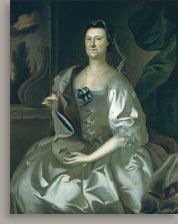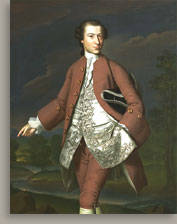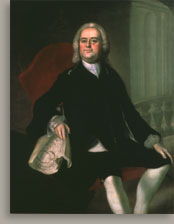 Joseph Blackburn
Joseph BlackburnColonel Theodore Atkinson, 1760
Description
Colonel Theodore Atkinson is a three-quarter-length portrait of a seated man whose body faces three-quarters to the right. The man’s head is turned slightly forward, and his eyes return the viewer’s gaze. He wears a white wig with curls that cascade onto his shoulders. He has blue eyes and a drooping proper right eyelid. The man has a long face, a long, straight, narrow nose, and sharp contours defining his cheeks near the base of his nose and around his mouth. His throat is fleshy beneath his chin. The subject’s skin is rendered in short, partially blended brushstrokes of reds and yellows with gray undertones and white highlights.
The man wears a white neck cloth with a bit of shirt ruffle visible at the top of the waistcoat. The white shirtsleeves end in semitransparent ruffles. His reddish-brown coat and waistcoat are trimmed with gold braid, and the buttons are covered in gold. His matching trousers are ornamented with four gold buttons and a yellow-brown strap over white stockings.
Atkinson is seated in a narrow, high-backed, upholstered chair next to a table draped in a shimmering blue cloth with loose folds. His proper left hand rests on his left thigh, and his right hand holds a quill pen with an ink-stained tip on top of two documents. The top paper, which is inscribed "Expences of Government," is folded and more writing is visible—but illegible—inside the fold. Attached to this page is the seal of the province of New Hampshire. The sheet of paper below this document is inscribed "Enlistmts returnd/for 1760"; again, writing on the interior fold is apparent but obscured in shadow. A third document, at the left edge of the canvas, is inscribed with the truncated name and city of the sitter:" . . . Atkinson Esqr/[Ports]mouth." There is a black, pyramidal inkwell on the table behind and to the left of the sitter’s coat sleeve. The background is of varying gray-brown tones.
Biography
Theodore Atkinson was born in New Castle, New Hampshire, on December 20, 1697, the son of Mary and Theodore Atkinson (1669–1719), a provincial councilor.1 Atkinson attended Harvard College with the class of 1718. Shortly after graduating, he received a commission as lieutenant of Fort William and Mary in New Castle, a position his father had occupied. In 1720 he was appointed clerk of the Court of Common Pleas, and by 1731 he was admitted as an attorney. In 1722, Atkinson was elected a representative to the General Court. Lieutenant Governor John Wentworth, who had been a close associate of Atkinson’s father, appointed the younger Theodore collector, naval officer, and sheriff of the province. During these years, New Hampshire was a royal province controlled from a distance by the governor of Massachusetts and, locally, by the lieutenant governor. The tension between the local and distant authorities resulted in a political rivalry between Massachusetts Governor Jonathan Belcher and New Hampshire Lieutenant Governor Wentworth. Consequently Belcher removed Atkinson from the first two positions and appointed another man to share the office of sheriff. Atkinson was appointed in 1732 councilor of New Hampshire, but Belcher stalled his appointment for two years.
When John Wentworth died in 1730, his son Benning (1696–1770) rose to power in his place and became the first royally appointed governor of New Hamsphire. Atkinson and the younger Wentworth remained political allies, and the two men dominated New Hampshire politics over the next generation. Atkinson was chosen secretary of the province in 1741, and passed the office to his son, Theodore, Jr., in 1760. Upon his son’s death in 1769, Atkinson resumed the office until 1775. He also served as clerk of the council and was promoted to colonel in the New Hampshire militia. In that capacity, he commanded one of ten New Hampshire regiments in the French and Indian War. In 1754, Atkinson was a delegate to the Albany Congress, which existed to form an alliance between the British colonies and the Iroquois tribes of the Six Nations. The committee ultimately presented a plan of union among the colonies to facilitate their defense, but both the king and the colonial governments rejected it.2 Later that year, Atkinson was appointed chief justice of the Superior Court and remained in that office until the Revolutionary government was formed in 1775. In 1773 he was promoted to major general.3
Then Atkinson’s power began to wane, as did that of the royally sanctioned government in general. In December 1774, he confronted a crowd threatening to seize Fort William and Mary, declaring that failure to disband would constitute an Act of High Treason and Rebellion. But instead of being obeyed, Atkinson was mocked.4 When he refused, in July 1775, to turn over the records of the province to the Revolutionary government in Exeter, and the documents were seized from him. Curiously, Atkinson was not named in 1778 among the Loyalists whose land the patriots confiscated, despite the elder statesman’s unambiguous political allegiance to the Crown. Close associates such as Benning and John Wentworth, on the other hand, were individually named in acts passed by the Revolutionary government of New Hampshire as "enemys" of the state, and their property was seized.5
Atkinson built a fortune in land investment. In 1719 he inherited a substantial sum, amounting to 1,200 pounds, from his father’s estate. In the mid-1730s, he moved to Portsmouth, where he helped establish an Anglican church—Queen’s Chapel, later renamed St. John’s—and was a warden of the Masons. In 1754 he gave land to the church for building tombs, Vaults & Monuments.6 He expanded his wealth as one of the principal investors in 1739 in the Masonian Proprietorship, which was based on a seventeenth-century land grant of all the property within sixty miles of the New Hampshire coast, including Portsmouth, Dover, and Exeter. That corporation’s success hinged upon the resolution of an ongoing boundary dispute between Massachusetts and New Hampshire, which was settled in 1741 in favor of Atkinson’s province and investment. Inhabitants of the towns established within the proprietorship were granted title to the land they had improved.7 Atkinson and his son also held seventy-three proprietorships in the contested land to the west of New Hampshire, which would later become Vermont.8 The town of Atkinson, New Hampshire, founded in 1767, was named for him.9
Atkinson’s taste for display prompted him not only to have his and his wife’s portraits painted by Joseph Blackburn but also to build a grand house on Court Street in Portsmouth. This residence contained a substantial amount of silver, including a tray engraved with birth and death dates of family members and friends.10 Atkinson apparently owned the finest carriage in town and once challenged another man to a sulky race from Portsmouth to Boston. His interest in sport is suggested by the dedication of the Reverend Joseph Seccombe’s so-called fishing sermon to him.11
On September 4, 1732, Atkinson married the widow Hannah Plaisted (1700–1769), daughter of his late political benefactor John Wentworth. This union added 1,000 thousand pounds to Atkinson’s wealth and further solidified his ties to the Wentworth family. Their children Hannah, who was baptized 1734 and died young, and Theodore (1737–1769)—both predeceased their parents.12 When Atkinson, who had no immediate heirs, died in Portsmouth on September 22, 1779, he left the bulk of his fortune to a cousin, George King, on the condition that he change his name to Atkinson. He also left 200 pounds to the Anglican church he helped found in Portsmouth for the distribution of bread to the poor on Sundays. In addition, Atkinson’s will included bequests of 100 pounds apiece to the libraries of Harvard and Dartmouth College; he had been appointed a trustee of the latter school in 1769. He specified that Harvard spend the funds for books "usefull in the Study of the Civil—Statute—& Common Law of England." And the books purchased by both colleges were to be impressed with Atkinson’s initials in gold letters on the binding.13
Analysis
 |
|
| Figure 1. Joseph Blackburn, Mrs. Theodore Atkinson, 1760, oil on canvas, 49 1/8 x 39 1/8 in. (124.7 x 99.3 cm), © The Cleveland Museum of Art, 2000, Gift of the John Huntington Art and Polytechnic Trust, 1919.1005. Copyright notice. |
Blackburn also painted Atkinson’s political allies and in-laws: Major John Wentworth (1759, New Hampshire Historical Society, Concord), Lieutenant Governor John Wentworth (1760, New Hampshire Historical Society, Concord), Benning Wentworth (1760, New Hampshire Historical Society, Concord), and Thomas Wentworth (1761, Fine Arts Gallery of San Diego). Lieutenant Governor John Wentworth was Atkinson’s father-in-law and Benning, his brother-in-law. Blackburn must have painted John Wentworth’s portrait from an earlier likeness, since the patriarch had died in 1730. In addition, Blackburn received commissions from Atkinson’s fellow provincial councilor and another investor in the Masonian Proprietorship, George Jaffrey (portrait location unknown), and his wife (and Mrs. Atkinson’s sister), Sarah Wentworth McPheadris Jaffrey (1761, Warner House, Portsmouth). An elite group of economically and politically entwined families in Portsmouth, as elsewhere in colonial America, cultivated portraiture.
 |
|
| Figure 2. John Singleton Copley, Theodore Atkinson, Jr., about 1757–58, oil on canvas, 49 1/2 x 39 3/4 in. (125.7 x 101 cm), Museum of Art, Rhode Island School of Design, Providence, Jesse Metcalf Fund. Photography by Del Bogart. |
Blackburn’s depiction of Colonel Atkinson typifies the artist’s later portraits in that it demonstrates a greater facility with modeling than his earlier work. Light falls from the top left of the painting, drawing attention to the face and hands, modeling the figure, and setting the body convincingly in space. Light illuminates the proper right side of the sitter’s face and produces a highlight along the edge of the nose, leaving the left side relatively dark and helping to shape the age lines around the features. The artist now models with chiaroscuro, not just line and color. Light also highlights the gold braid and the peaks on the folds of the blue tablecloth. Finally, it emphasizes thematic elements; for example, light leads our eye to the sitter’s hands, especially the index finger that steadies the quill.
Colonel Theodore Atkinson is characteristically strong in its representation of fabrics and still-life objects, which were selected to elaborate upon Atkinson’s public life. Blackburn convincingly distinguished the matte broadcloth worn by the sitter from the more reflective surface of the textile draped over the table. The colonel’s coat and waistcoat are trimmed in gold braid, and his buttons are covered with the same, all of which project a glinting light and suggest his wealth. The document right under his hand bears the heading "Expences of Government", probably a reference to his offices as secretary of the province of New Hampshire and provincial councilor. The portrait suggests that the viewer has interrupted Atkinson while he is at work. The sheet below, which refers to his role in defending the province, is inscribed "Enlistmts returnd/for 1760"; that was the year Atkinson sat for the portrait as well as when New Hampshire contributed to the British colonial effort to defeat the French at Montreal. The third document identifies the sitter by surname and city of residence.
 |
|
| Figure 3. Joseph Blackburn, Benjamin Green, 1756, oil on canvas, 50 1/4 x 40 1/4 in. (127.6 x 102.2 cm), Montclair Art Museum, Montclair, New Jersey, Gift of Clayton E. Freeman, 1957.1. |
Similar compositions were common among eighteenth-century British and American painters. For instance, Thomas Hudson, who possibly was Blackburn’s teacher, painted the composer George Frideric Handel (in 1747, National Portrait Gallery, London) seated with papers and musical compositions at his side.21 John Smibert (1688–1751), the Scottish-born, London-trained follower of the Lely-Kneller school, painted Henry Ferne in 1730 (Worcester Art Museum) in a similar manner. That portrait was completed in London before Smibert moved to Boston, where he was the leading portraitist until his health began to fail in the mid-1740s. The American limner Joseph Badger also employed the convention of a businessman at work in his portrait Cornelius Waldo (1750), which derived in part from an imported English mezzotint of Sir Isaac Newton by John Faber, Jr. (after John Vanderbank). Copley, too, interpreted this theme in such portraits as John Hancock (1765, Museum of Fine Arts, Boston), Thomas Boylston II (1767, Harvard University Portrait Collection, Cambridge, Massachusetts), and Robert Hooper (1767, Pennsylvania Academy of the Fine Arts, Philadelphia).
The Detroit Institute of Arts acquired a portrait in 1929 that was attributed to Blackburn and said to represent Colonel Theodore Atkinson, but the work is no longer considered authentic. A three-quarter-length view of a seated man, it is, in many ways, the mirror image of the Worcester Art Museum’s painting: the figure faces three-quarters left and wears a long wig and a suit trimmed in gold braid. The right hand rests on a book open on a table at left, and the right hand is tucked into the open waistcoat. The Detroit painting was published in 1930 as an example of Blackburn’s lack of inventiveness.22 However, in 1943 the art historian Edgar P. Richardson declared it "an ingenuous fake,—an English portrait which resembled the real Blackburn in costume and pose had a careful copy of the Atkinson head painted over its own quite different countenance."23
Notes
1. For Atkinson’s biography, see Bell 1894, 23–25; Sibley and Shipton VI, 1942, 221–31; Wilderson 1994; and Jere R. Daniell, Atkinson, Theodore, in ANB I, 716.
2. McAnear 1953, 727–46.
3. For Atkinson’s military career, see Potter 1972, 82–83, 223 n, 258, and 261.
4. Wilderson 1994, 246.
5. New Hampshire Laws IV, 1916, 191.
6. McLaughlin 1982, frontispiece.
7. Hammond 1916, 245–63.
8. Wilderson 1994, 187.
9. Adele Dillon, Secretary, Atkinson Historical Society, to Laura K. Mills, May 4, 1999, object file, Worcester Art Museum.
10. Brewster 1972, 62–75.
11. Seccombe 1743.
12. Wentworth 1878, 299, lists Hannah and Theodore. For Theodore, Jr.’s death, see New-Hampshire Gazette, and Historical Chronicle, November 3, 1769, and for Hannah’s death, December 15, 1769.
13. Theodore Atkinson, Will, December 12, 1775, Department of State, Division of Records Management and Archives, Concord, N.H.
14. Aykroyd 1975, 242–43.
15. Neither the writer nor is the date is identified. A Mrs. Henry Atkinson, who provided the information, is cited in a memorandum from Louisa Dresser to George Stout, September 21, 1950, object file, Worcester Art Museum.
16. Janet L. Comey, catalogue entry, in Rebora 1995, 178–81.
17. Copley News 1943, 114–15.
18. Morgan and Foote 1937, 21–22 and opposite; advertisement, The Magazine Antiques 118, no. 6 (December 1980): 1087.
19. Stevens 1967, 99–100.
20. Caldwell and Roque 1994, 33, 35–36
21. The observation that Blackburn’s work reflects the influence of Thomas Hudson or Joseph Highmore was first made in Park 1919a, 75–78. Park shortly thereafter asserted that Hudson may have been his master (1923a, 8). For the portrait of Handel, see Miles and Simon 1979, cat. no. 34, n.p. Such portraits are also closely related to the long tradition of scholar portraits, in which the papers are letters, scientific treatises, maps, and other indications of scholarship. That tradition was recently examined in Fortune and Warner 1999.
22. Bolton and Binsse 1930a, 51.
23. Richardson to Charles Sawyer, January 21, 1943, object file, Worcester Art Museum.